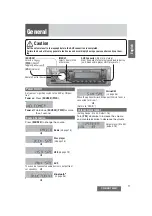
Introduction
HE4000 Encoding System
2.5.7 Fault Relay
The Fault Relay is an RJ-11 connector. The fault relay is used in a redundant configuration. In
this configuration input is fed from distribution amplifiers into each of two HE4000s. A
ComtechTV redundancy switch monitors the output through the Fault Relay. If the primary
HE4000 faults, the secondary HE4000 automatically takes over operation.
A relay fault condition is defined as:
•
A unit power failure.
•
Unit power switch turned off.
•
Unit is unplugged.
•
A unit hardware failure.
The fault condition is indicated by contact closure between pins one (1) and three (3) and open
contacts between pins one (1) and six (6). The non-fault condition is indicated by contact closure
between pins one (1) and six (6) and open contacts between pins one (1) and three (3).
The illustration indicates the physical locations of pins 1 and 6 within the fault relay port, as
viewed from the rear panel.
When the fault relay detects a fault condition, the fault relay trips, and the Status LED located on
the HE4000 front panel illuminates red.
The HE4000 multiplexer outputs an ASI transport stream with a variable rate of 1 to 160 Mbps.
This transport stream is the combination of the video, audio, and auxiliary data streams in an
MPEG-2 compliant transport stream. The transport stream is always available at the ASI output
ports even if a modulator is installed and operating
2.6 Transport Connection Ports
2.6.1 ASI Out
ASI Out Primary is a female BNC connector with 75Ω impedance. The port outputs a DVB-
compliant ASI transport stream at rates between 1 and 216 Mbps.
2.6.2 ASI Out Secondary
ASI Out Secondary is a female BNC connector with 75Ω impedance. The port outputs a copy of
the primary transport out.
ASI Out Secondary port can be used to output the transport stream of one HE4000 to the
multiplexer of the HE4000 for MPTS operation. In this configuration, this port is cabled to the Mux
ASI In port of the HE4000 in the MPTS chain.
2-12
01-0951-404 Rev B
















































